
|
Milton Train Works™Custom kits and custom models |
A proud member of |
|
This intruiging custom kit builds a classic model of a drop center flatcar with an impressive, fully rigged, transformer load. Drop Center flatcars are used around the world whenever a load needs to be transported by rail that is too tall for standard flatcars to carry and still satisfy clearance requirements. Thus this model is at home on both North American prototype layouts and others. This model is the first Milton Train Works™ kit to use string, and is my most heavily "Technic™" model yet. More about that later. |
|
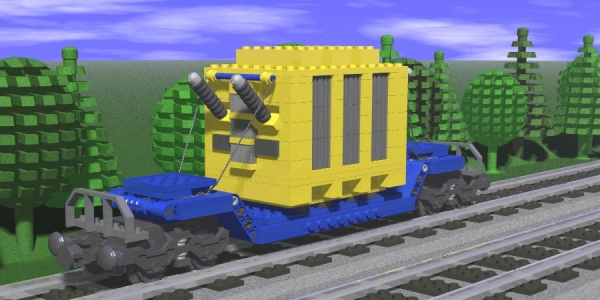
Instruction Cover shot |
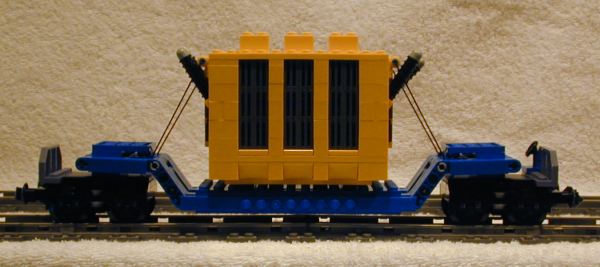
Side View |
|
This side view really highlights what a rugged model this is. Clever use of technic bent beams give the drop center a much more prototypical look than LEGO®'s one piece drop plate ever could. End handrail platforms on the trucks simulate the multitruck platforms that bigger cars use without adding too much bulk or expense. The transformer load clearly wildly exceeds the standard loading gauge. You can also see clearly how much realism the rigging (non LEGO® nylon string, matched as closely to specification as practical, indistinguishable in every respect from authentic string) adds to the model. Specially designed tauteners ensure that the rigging adjusts to any load you care to place on the car. |
|
This shot puts the car in perspective. Contrast it with the MTW-2001 switcher hard at work to shift this car and with the bulkhead flat end of the MTW-1002 just visible at the fore. Why a Drop Center flat? As a young boy I had many Lionel® catalogs. One of my favorite cars was always the "Drop Center with Transformer Load" which had been a mainstay of the line for many years. When a good supply of the necessary parts became available (because I cleaned out a bit of my basement and came across a windfall of sets I'd forgot I had) this car was a natural. The yellow transformer color, while a bit "Lionel"-ish, is in fact quite prototypical. |
|
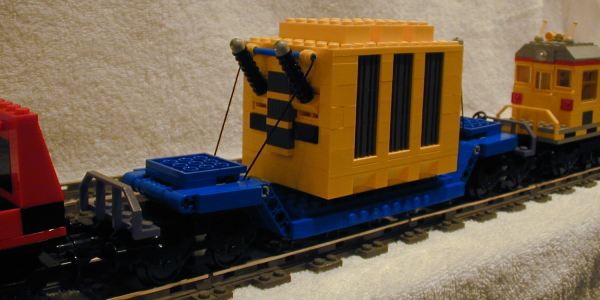
Three Quarters View |
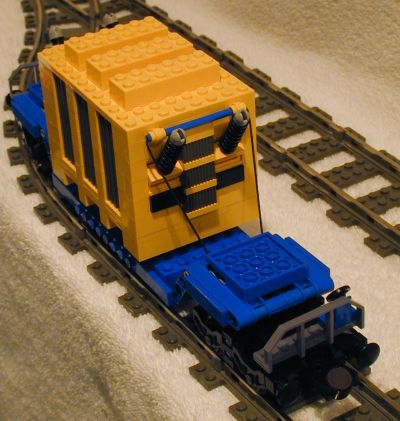
Oblique View |
|
This shot gives a good view of the end platform with brakewheel (the other end has none), as well as highlighting the rigging. The shot also shows that the car is a bit wider than 6 wide, as I chose to put some plates and tiles along the outside edges to give the body sill sides a more finished look. Just visible in this shot is one of the truck sideframes. I'm rather pleased with how the grey rounds simulate the truck rigging, and I've standardised on this truck where car length allows it (this is the same truck used in MTW-1002 and MTW-1003, but with an end platform). As noted the end platform is typically seen on multi truck cars, but I wanted MTW-1004 to look good on the tight radius curves we're stuck with. While I wanted a nice beefy car, it's not so big that it looks silly navigating S bends, as it might have if I had went with two trucks per end. |
|
A closeup showing the transformer details. While no specific prototype was followed exactly, this load will be easily recognised by all but the most militaristic. No, those aren't ray gun ports on the end, they are elaborate insulators mounted at the proper prototypical diagonal angle. There are also center cooling vents (transformers run hot and need active heat dissipation mechanisms) and equipment plates below the insulator mount points. Also just visible are the side ventilators which run almost the entire height of the transformer. Note also the rigging detail. There is a load rigging bar built right into the transformer side that the rigging line (string) goes through. You can see the other end of the rigging emerging from recesses in the frame. The rigging is wound onto takeup reels and the 4x4 plate holds those reels taut via a 8 tooth gear based latchdown mechanism. Photos in the instructions clearly show the somewhat tricky assembly steps in this area so you too can enjoy the pleasure of a snuggled down load, knowing your load is safe and secure. |
|
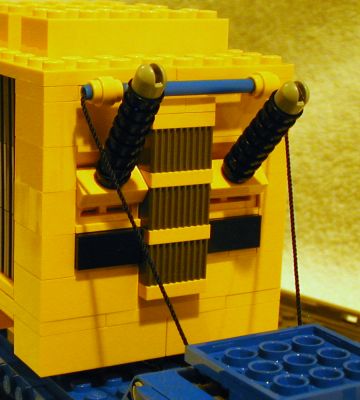
Transformer Detail View |
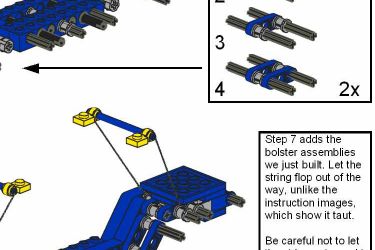
Excerpt from color instructions |
|
As with all Milton Train Works™ models, you get a fantastic set of instructions, featuring cropped views, cutaways, subassemblies and other nuances to make this a fast and fun build. These instructions, while not quite "The LEGO® Group" quality, are amazingly close and are thorough and accurate. They will allow you to quickly and correctly assemble this set. You will receive a high quality printed or photocopied set of instructions and a parts list, as well as all the required parts to create one instance of the set. Note that color instructions are an extra cost option, you will be able to assemble the set with the standard black and white but will enjoy the set more if you spring for the color. Why hold back? The color instructions are gorgeous! |
|
Here we have another excerpt from the instructions. This image shows several of the substeps used in transformer load assembly. These instructions were created with MLCad, an LDraw compatible CAD modeling program especially designed for use with LEGO® and compatible elements. I created some custom LDraw elements specifically for this model, to allow me to model string in the instructions. After the painstaking transcription, I checked the instructions for accuracy, generated the parts list and had a fellow Bricksmith™ print them, doublesided, on a color laser printer, ensuring that you get the sharpest instructions offered by any limited run custom LEGO® kit producer on the market today. (the black and white instructions are printed on my own high speed 600 DPI HP 2100 LaserJet™) Please note, special newly devised techniques have been employed in the instruction generation and rendering process to ensure that the part outlines are clearly visible and that you will have no trouble telling part boundaries whether you get color or black and white instructions.
Sorry, instructions are NOT available separately. No exceptions. |
|
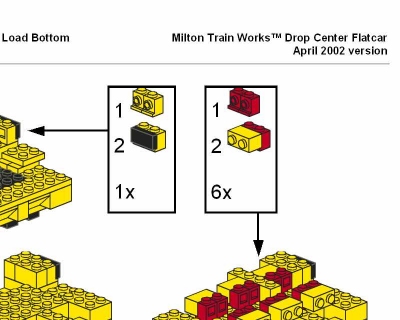
Excerpt from instructions |

Layout scene |
|
Here is a scene from a layout (the 24 March 2002 NELUG™ NETCA show, to be exact, more images can be seen here). In this shot a preproduction version of the car is bracketed by Eric Kingsley's beautiful Boston and Main Geep and caboose. This shot really highlights how great this model looks in context on layouts, whether club layouts at major shows, or on that special layout in your basement. |
Note that some images may be from the preproduction version.
|
This model, the eighth all new and completely original design from Milton Train Works is sure to be very popular, and these may be a collectors item some day, since this is a strictly limited run. Don't let this opportunity pass you by, your layout needs one (or more) of these. It's just the thing for moving those bulky loads, or bringing some realistic action to your layout. Buy today! |
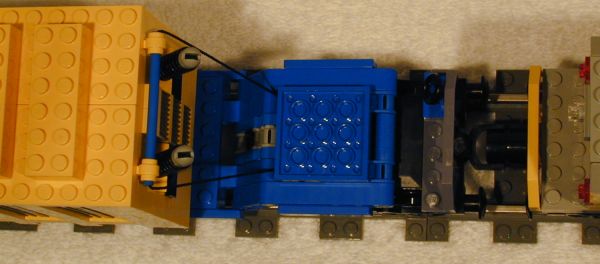
Top view of end |